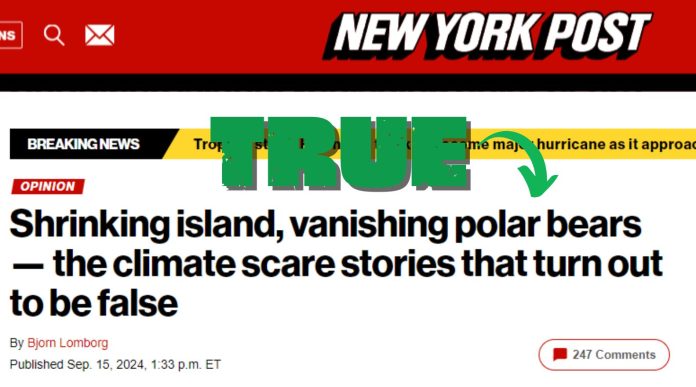A recent article at the New York Post by Bjorn Lomborg, titled “Shrinking island, vanishing polar bears — the climate scare stories that turn out to be false,” points out that many of the harms the mainstream media claims climate change is supposed to be causing, for example, to polar bears, the Great Barrier Reef, and Pacific island nations, have not happened. This is true. None of the catastrophes that climate alarmists crow about have come to pass.
Lomborg writes that two major themes can be seen in the last 20 years of climate change coverage from government and media: “stubborn unwillingness by campaigners to acknowledge any inconvenient science, and ever-shifting favorite stories, first elevated and then dropped by the wayside.”
He says the one constant throughout those shifting stories is “a fixation on scaring the public, which has in turn shaped bad climate policies.”
This is true; illustrated nicely by the shifting narratives surrounding global greening in particular. Years ago, the dominant narrative was that desertification, or the deaths of lush ecosystems, was our future due to climate change. This was presented as a looming catastrophe in the media and in schools. Now that decades of data show the reverse is happening, that leaf coverage is actually expanding over time amid modest warming, the alarmists say the greening is dangerous, as covered in detail in this Climate Realism post.
Lomborg explores a variety of examples illustrative of climate crisis stories that are false, and sometimes abandoned or downplayed as they have falsified by data that has emerged over time. One case study Lomborg discusses is the polar bear craze.
He writes that “after years of misrepresentation, it finally became impossible for them to ignore a mountain of evidence showing that the global polar bear population has increased substantially from around 12,000 in the 1960s to around 26,000 in the present day.”
The alarmist media has tried to claim that melting sea ice is causing more polar bear encounters and aggression towards humans. However, the simpler explanation is that there are so many more bears than there used to be, and also more human beings in areas where bears naturally live. This is another attempt for media to spin a positive (bear populations recovering from previous overhunting) into a negative.
The second false alarm case study that Lomborg discusses is the missing decline of Australia’s Great Barrier Reef (GBR) and other coral reefs.
Lomborg recalls that “scientists predicted the reef would be decimated by 2022,” and “The Guardian even published an obituary.” He points out that the GBR has more coral cover right now in 2024 than at any point in time since recordkeeping began in 1985.
“The good news gets a fraction of the coverage that the scare stories did,” Lomborg writes.
Climate at a Glance and Climate Realism have repeatedly had to debunk false claims made in the media that the GBR and other barrier reefs are declining, so Lomborg’s point is accurate. It is rare that the media hypes any good news the way it does bad news about various ecosystems such as the GBR, a embarrassing admission from them after they spent decades catastrophizing about it. Even when they do begrudgingly report the record coral extent and data trends, both globally and in the GBR, they can’t help but try to warn that they still might suddenly reverse course and die off.
Lomborg’s also refutes claims that islands like Tuvalu are sinking below the waves because of rising sea levels. He points out that “almost all atoll islands are increasing in size,” which the New York Times (NYT) only just decided to share with their readership earlier this year, who, if they only relied the NYT for their knowledge of the issue, up to that point had likely been under the impression that the opposite was true.
“While rising sea levels do erode land, additional sand from old coral is washed up on low-lying shores,” Lomborg explains, and “studies have long shown this accretion is stronger than climate-caused erosion, meaning the land area of Tuvalu is increasing.”
It’s not just that; scientists have known for decades that atoll islands uniquely change with changing sea levels, scientists from over a hundred years ago such as Charles Darwin proposed that reef-based islands grow upwards towards the light even as sea levels change. In 2010, multiple studies reported that Tuvalu and other islands were actually growing. Eight of the nine coral atolls in Tuvalu have grown, and 75 percent of the nation’s smaller islands have also grown.
It is heartening when major news publications like the New York Post publish work done by Lomborg and other climate realists, who bravely insist on relying on available real-world data in the face of an onslaught of stories and reports referencing scary climate model scenarios. No doubt the Post will get some hate mail for it, but it is a sign of a good news organization dedicated to serving its reader’s interests by following the facts where ever they lead, even on controversial topics, to publish the truth, however unalarming, rather than hyperbole and lies.
















